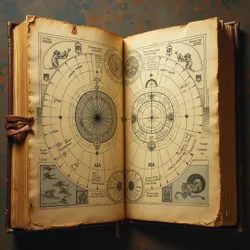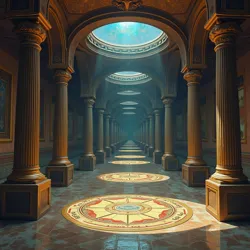Celestial Codex
The Celestial Codex stands as one of humanity's most enigmatic and revered spiritual texts, combining ancient stellar prophecies with intricate astronomical observations that continue to influence modern space travel and religious practices. First discovered among the ruins of the Ancient Stellar Temple on Mars, this comprehensive collection of manuscripts, star charts, and prophetic writings has shaped humanity's understanding of divine presence in space for over three centuries.
 A preserved page from the original Celestial Codex, showing intricate stellar calculations and prophetic annotations
A preserved page from the original Celestial Codex, showing intricate stellar calculations and prophetic annotationsOrigins and Discovery
The Celestial Codex was uncovered during the earliest days of Martian exploration by members of the Star Shepherds, who recognized its significance after comparing its contents with their own theological records. The text itself appears to predate human space travel, suggesting either extraordinary prophetic insight or, as some scholars propose, the influence of the Celestial Assembly in its creation.
Written in multiple ancient languages, including several previously unknown scripts, the Codex required decades of careful translation and interpretation. The breakthrough in understanding its contents came when scholars from the Void Mother's Navigators noticed that certain passages aligned perfectly with observable stellar phenomena, leading to the establishment of the Bureau of Prophetic Astronomy.
Structure and Contents
The Celestial Codex consists of twelve primary volumes, each corresponding to what the ancient authors identified as a different aspect of divine manifestation in space. The text interweaves precise astronomical calculations with poetic descriptions of cosmic events, many of which have been validated by modern observations. Perhaps most remarkably, the Codex contains detailed descriptions of phenomena that would not be discovered until centuries after its writing, including the Divine Convergence Zone.
Each volume of the Codex is divided into three distinct sections: observational records, prophetic narratives, and what scholars term "navigational mysteries." These last sections have proved particularly valuable to the Stellar Clergy, as they contain detailed instructions for traversing what the ancients called "divine currents" in space - paths that modern ships have found to be remarkably efficient for faster-than-light travel.
Prophetic Accuracy
The Codex's most striking feature is its extraordinary predictive accuracy regarding cosmic phenomena. Its description of the Void Mother's Embrace constellation's formation preceded actual astronomical observations by over two centuries, while its prophecies regarding the emergence of Astral Divinities have been repeatedly validated by documented manifestations throughout human space.
 The Prophecy Verification Chamber at the Sanctum of Celestial Patterns, where scholars compare Codex predictions with real-time stellar observations
The Prophecy Verification Chamber at the Sanctum of Celestial Patterns, where scholars compare Codex predictions with real-time stellar observationsModern Applications
In contemporary space travel, the Celestial Codex serves as more than a historical or religious document. The Observatory of Measured Truth has confirmed that many of its astronomical calculations remain remarkably accurate, leading to the development of the Codex Navigation Protocol, a hybrid system that combines ancient wisdom with modern technology.
Vessels like the Pilgrim's Bounty incorporate Codex-based navigation systems alongside conventional instruments, particularly when traversing regions of space known for unusual phenomena. The text's insights have proved especially valuable in understanding and navigating the recently discovered Divine Convergence Zone, where traditional navigation methods often prove unreliable.
Academic Study
The study of the Celestial Codex has spawned its own academic discipline, known as Codex Theology. This field combines elements of astronomy, archaeology, linguistics, and religious studies. The Institute of Codex Studies on Mars maintains the original manuscripts and coordinates research efforts across human space, while satellite facilities at major universities throughout the Helios Concordat focus on specific aspects of the text.
Controversial Interpretations
Despite its demonstrated accuracy in many areas, the Celestial Codex remains a source of controversy among scholars and religious leaders. The Path of Burning Light advocates for a purely scientific interpretation of the text, arguing that its prophecies represent advanced astronomical calculations rather than divine inspiration. In contrast, traditional religious orders maintain that the Codex's accuracy proves its divine origins.
Conservation and Access
The physical preservation of the Celestial Codex represents one of humanity's greatest conservation challenges. The original manuscripts are housed in specially designed vaults aboard the Archive Ship Mnemosyne, a vessel that maintains a precisely controlled environment to prevent degradation of the ancient materials. Digital copies are widely available, but many scholars insist that certain passages can only be properly interpreted when viewed in their original form.
Cultural Impact
Beyond its religious and navigational significance, the Celestial Codex has profoundly influenced human culture in space. Its imagery and prophecies have inspired countless works of art, architecture, and literature. The design of many modern spacecraft, including the distinctive features of the Stellar Watchtowers, draws directly from Codex descriptions of sacred geometry and divine proportion.
See Also
- Codex Interpretation Protocols
- Martian Archaeological Archives
- Divine Realm Mapping Project
References
- Annals of the Star Shepherds, Volume VII
- Proceedings of the Conclave of Digital Theologians
- Archives of the Void Mother's Navigators
- Helios Concordat Historical Records
This article is maintained by the Institute of Codex Studies and the Stellar Clergy Historical Division